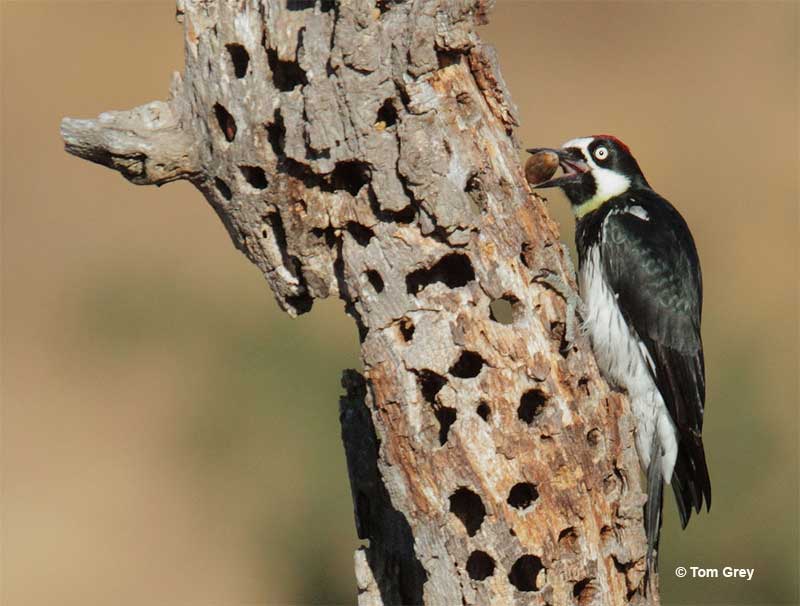
Colorado is an excellent place to see a variety of woodpecker species. Downy Woodpeckers and Northern Flickers are common and easy to see, gorgeous Williamson’s Sapsuckers live high in the mountains, and more woodpeckers live in other parts of the state.
But more importantly, how many woodpeckers have you seen in Colorado? Were you able to identify all of them?
Most Common Woodpeckers In Colorado
Based on recent eBird data, we made a list of the most common woodpeckers in Colorado and arranged them from most common to least common.
To help identify these beautiful birds, we also included information about their behavior and key field marks.
Northern Flicker

Scientific name: Colaptes auratus
Length: 12.5 inches
Wingspan: 20 inches
Northern Flickers are big, unique, gray and tan woodpeckers with bold white rumps. They have buff underparts with black spotting and a bold black patch on their chest, and fine black barring on their back and wings.
This species has some differences depending on where they live. Birds east of the Rocky Mountains have a small red spot on their nape, and a black moustache mark (males). Eastern birds also have bright yellow underwings.
West of the Rockies, Northern Flickers have grayer heads, and males have a red moustache. They also have reddish on their underwings.
Northern Flickers love parks, golf courses, and other semi-open habitats. In such places, we often see them in bounding flight, or perched on the ground as they forage for ants. These noisy birds also make laughing calls and “wicka-wicka” vocalizations.
Since this species eats ants, it rarely if ever comes to bird feeders.
Key identifications:
- In most of their range, Northern Flickers are the only woodpecker with gray and brown plumage.
- This species has a gray crown and fine black barring on its tan-colored back.
- Northern Flickers also have a black chest patch and black spotting on their underparts.
Downy Woodpecker

Scientific name: Dryobates pubescens
Length: 6.75 inches
Wingspan: 12 inches
Downy Woodpeckers are small, cute woodpeckers with black and white plumage. They have bold, black and white markings on their heads, black and white wings, and white underparts.
They also have a white back, black rump, and black and white tail. This woodpecker is slightly bigger than a sparrow, and has white, tufted feathers above its short beak.
Male Downy Woodpeckers have a small red patch on the back part of their head. Females look like males but lack this red patch, and young birds have red on the top of their heads.
This small bird is common in all sorts of wooded habitats. They like to use their small beaks to peck into twigs and often forage with flocks of chickadees and other birds.
This beautiful little woodpecker is also a regular visitor to backyards and can live in urban areas with lots of trees. They also come to bird feeders, especially ones that offer suet and peanuts.
Key identifications:
- Downy Woodpeckers are smaller than all other woodpeckers in North America. They are nearly as small as a House Sparrow.
- This species has a short and stubby beak (for a woodpecker).
- Downy Woodpeckers have small dark markings on their white outer tail feathers.
Hairy Woodpecker
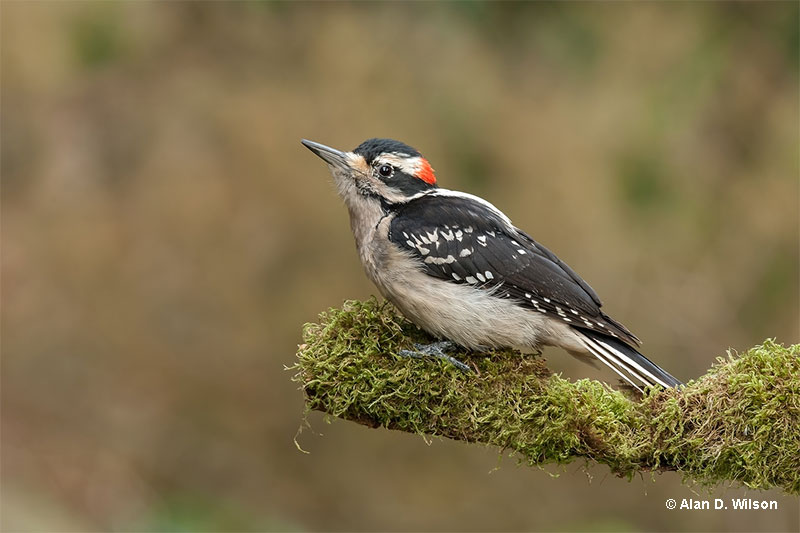
Scientific name: Dryobates villosus
Length: 9.25 inches
Wingspan: 15 inches
Hairy Woodpeckers are medium-sized, black and white woodpeckers with a fairly long and sharp beak. They have a bold black and white pattern on their head, white back, black rump, and black and white wings.
Hairy Woodpeckers also have white underparts and a pale front. Males have a small red patch on the back of their head, females lack this patch, and juveniles have a red patch on top of their head.
If that description sounds like a Downy Woodpecker, it’s true, these two species look almost exactly the same! However, in addition to details mentioned below, they also differ in another main way.
While Downy Woodpeckers like second growth and plants with thin stems, Hairy Woodpeckers only live in places with big, mature trees. We mostly find these woodpeckers in forest but they can also occur in parks and suburban areas that have lots of big trees.
Hairy Woodpeckers can also visit feeders, especially for suet.
Key identifications:
- Hairy Woodpeckers have noticeably longer beaks than Downy Woodpeckers, and are also larger birds.
- The Hairy Woodpecker has a big white patch on its back.
- This species has plain white underparts and clean white outer tail feathers.
Lewis’s Woodpecker
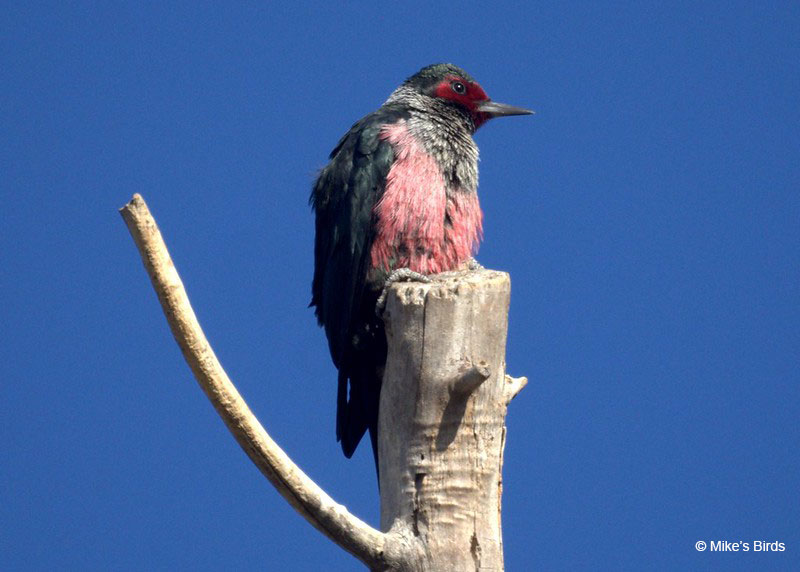
Scientific name: Melanerpes lewis
Length: 10.75 inches
Wingspan: 21 inches
The Lewis’s Woodpecker is a unique, fairly large woodpecker with a dark red face, silver-gray collar and chest, and magenta-pink underparts. The rest of its plumage is blackish green.
Both sexes look alike while juveniles lack bright colors and have brownish heads.
Unlike most woodpecker species, the Lewis’s Woodpecker prefers semi-open areas with big, scattered trees. They are especially common in open Ponderosa Pine forests, riparian zones with big Cottonwoods, and burned areas.
Oddly enough, since Lewis’s Woodpeckers aren’t good at excavating holes in hard wood, they require old, decayed trees for nesting. In summer, this species also needs areas with plenty of insects.
They fly out from a perch to catch their insect prey, often flying in an odd and floppy fashion! In winter, Lewis’s Woodpeckers move to lower elevations where they store and eat acorns and other nuts.
We can see this beautiful bird in parts of southern British Columbia and in the western USA.
Key identifications:
- Blackish, glossy green plumage.
- Pink belly.
- Silvery collar.
Red-headed Woodpecker

Scientific name: Melanerpes erythrocephalus
Length: 9.25 inches
Wingspan: 17 inches
Red-headed Woodpeckers are beautiful, medium-sized woodpeckers with a completely deep red head. Adults of both sexes look alike and have a sharp gray bill, and bright white underparts.
Their upperparts are glossy black with a snow-white rump, and big white patches on their wings. Juvenile Red-headed Woodpeckers have a similar plumage pattern but have a gray-brown head, and some dark markings on their wings and underparts.
This striking bird prefers semi-open habitats with mature oaks, snags, and other big trees. We see them on golf courses, at the edges of rivers and other wetlands, and other places with similar-looking habitat.
In some places, this beautiful bird also occurs in urban areas, especially in the southeastern USA.
Red-headed Woodpeckers like to peck into trees like other woodpeckers but they also catch insects in flight. With that in mind, we often see them sallying into the air from tall snags next to open areas.
Key identifications:
- Red-headed Woodpeckers are the only woodpecker species in eastern North America with an entirely red head.
- This species has a unique wing pattern with big white patches on the base of each wing.
- The Red-headed Woodpecker has a black tail and an extensive white rump.
American Three-toed Woodpecker
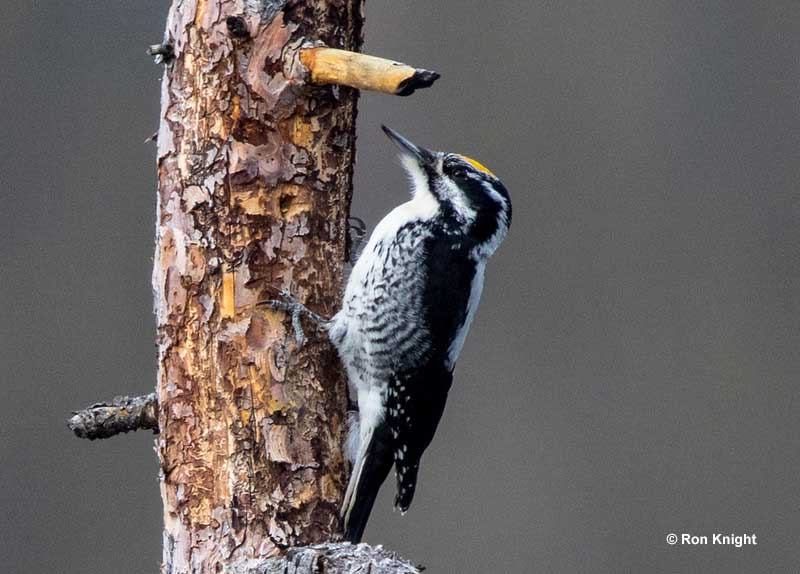
Scientific name: Picoides dorsalis
Length: 8.75 inches
Wingspan: 15 inches
The American Three-toed Woodpecker is a black and white woodpecker of cold, northern forests and high elevations. True to its name, it does indeed have three toes!
This species has black barring on its flanks, and a narrow white line on the lower part of its black face. The rest of its upperparts are black with some white barring on its back.
Rocky Mountain birds have a lot more white on their back. The first time I saw one in Colorado, at first, I thought I was seeing a Hairy Woodpecker!
Males and juveniles also have a small yellow patch on their crown, and females have narrow white eyebrows.
American Three-toed Woodpeckers flake off bark to reach beetle larvae and other bugs. They prefer mature coniferous forest, and also use lightly burned areas, two years after the fire took place.
We find these uncommon birds in Alaska, Canada, and the Rocky Mountains.
Key identifications:
- Mostly black head with small yellow crown patch.
- Narrow white line on the lower part of its face.
- White marks on its back and black barring on its flanks.
Ladder-backed Woodpecker
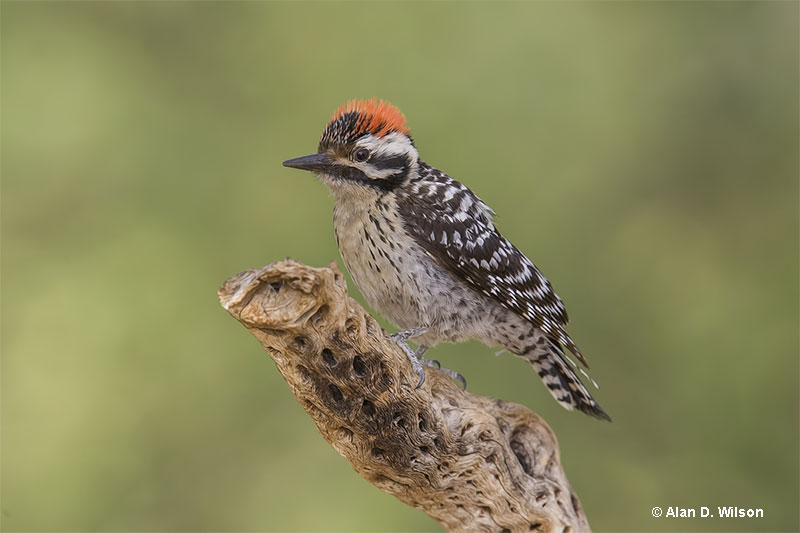
Scientific name: Dryobates scalaris
Length: 7.25 inches
Wingspan: 13 inches
The Ladder-backed Woodpecker is a small, black and white woodpecker of arid zones. It has a black and white “zebra” pattern on its back and wings, and some black speckling on off-white underparts.
Ladder-backed Woodpeckers also have a pair of thick black lines on their face, buff front, and a sharp, medium length beak. Males and juveniles have a red patch on the top of their head while females have a black crown.
Pairs of this small woodpecker pick insects and other arthropods from cactus and the trunks and branches of scrubby vegetation and small trees. They don’t peck into bark as much as other woodpeckers, and females forage more on twigs while males stick to trunks and larger branches.
Ladder-backed Woodpeckers are common in deserts and scrubby arid habitats. We find this handsome little woodpecker in many parts of the American Southwest as well as Texas north to southeastern Colorado.
Key identifications:
- Barred, black and white back.
- Two black lines on a pale face.
- Some black speckling on pale buffy underparts.
Red-bellied Woodpecker
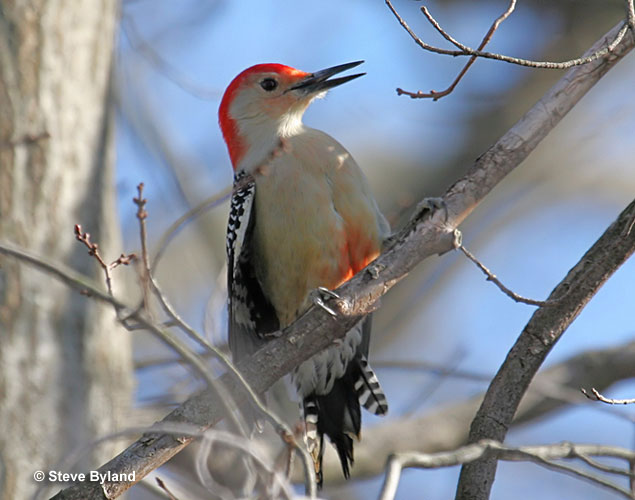
Scientific name: Melanerpes carolinus
Length: 9.25 inches
Wingspan: 16 inches
Red-bellied Woodpeckers are bold birds with a long, dark, chisel-like beak, and backs with zebra-like barring. They also have black and white bars on their long, closed wings, and a bold white rump with some black speckling.
Despite their name, it’s really hard to see the red on this bird’s underparts! Although they do have a bit of red or reddish-orange, it’s hidden on the lower part of their belly. The rest of their underparts and face are a pale gray-buff color, and they have a bit of orange above their beak.
Male Red-bellied Woodpeckers have bright red on their crown and nape. Females only have red on their nape and young birds only show a bit of orange on the back of their head.
We see pairs of this common woodpecker species in all sorts of woodlands. As long as big trees are present, they can even live in urban areas, and often come to feeders.
Key identifications:
- In most of their range, Red-bellied Woodpeckers are the only woodpecker species that has zebra-like, black and white barring on their back and wings.
- Red-bellied Woodpeckers have a pale face and red on their nape.
- This species has plain buff-gray underparts.
Acorn Woodpecker
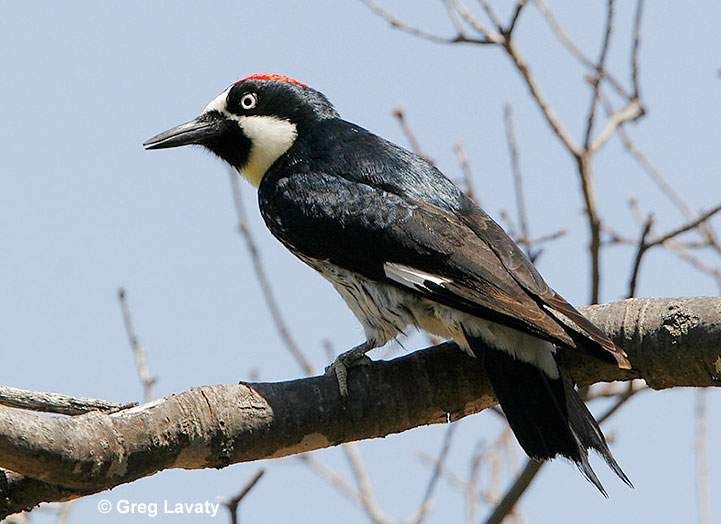
Scientific name: Melanerpes formicivorus
Length: 9 inches
Wingspan: 17.5 inches
Acorn Woodpeckers are bold, clown-like woodpeckers with a straight black beak, pale yellowish throat and front, and pale eyes. They also have a black chest, some black streaking on their underparts, and a bright white rump.
The rest of their upperparts are glossy black, and they have a red patch on their crown (larger in males). In flight, Acorn Woodpeckers show a bold white patch on each wing.
These woodpeckers are noisy and conspicuous birds that call from trees, posts, and other perches. We usually see them in small groups that forage for insects and other food items on oaks and other trees.
Most of all, Acorn Woodpeckers feed on acorns. They also store them for later use, sometimes sticking thousands of acorns into rows of small holes!
This fun woodpecker is easy to see in oak and pine-oak woodlands in California, western Oregon, eastern Arizona and adjacent New Mexico, and the Big Bend area of Texas.
Key identifications:
- Clown-like face.
- White wing patches.
- Black chest.
Colorado Woodpeckers: FAQ’s
What is the most common woodpecker in Colorado?
The most common woodpecker in Colorado is the Northern Flicker. According to eBird, this pretty woodpecker is seen more often than any other woodpecker species in the state.
How many woodpecker species does Colorado have?
Colorado has 11 woodpecker species along with two more species that are rare vagrants.
Do woodpeckers live in Colorado throughout the year?
Yes, most woodpeckers live in Colorado throughout the year.
Conclusion
In Colorado, most woodpeckers are doing well and easy to see. The state has large areas of forest and woodlands- lots of great habitat for woodpeckers!
However, several species only occur in limited regions or certain elevations. This can sometimes make birds like the American Three-toed Woodpecker and Ladder-backed Woodpecker a bit hard to find.
Even so, if you visit the right places, you should see them!
None of the woodpeckers in Colorado are threatened. A couple species, the Red-breasted Sapsucker and the Acorn Woodpecker, are rare vagrants to the state. However, these birds are common in the regular parts of their range.
More in Colorado: Most common birds | Hawks | Owls | Ducks | Hummingbirds | State Bird

